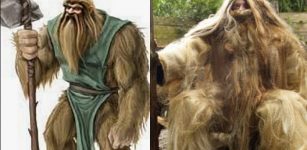The Bimaran Casket – Rare Golden Artifact Found In Ancient Stupa
A. Sutherland - AncientPages.com - This tiny artifact, the Bimaran Casket, is only 7 cm (2 3/4 in) high. It is made of gold and was discovered without its lid. The bottom of the artifact is decorated with a lotus, which symbolizes purity and beauty in Hinduism and Buddhism.
The Bimaran relic is cylindrical and covered with relief carvings of eight figures hammered from the reverse. CC BY-SA 3.0 - Photo credits: British Museum
The artifact, probably Indo-Greek work, is a small ancient Buddhist box for relics and represents a rare iconography.
It was found inside the stupa chamber at Bimaran, an ancient site northwest of India, on the right bank of the Kabul river.
His discoverer is the archaeologist Charles Masson (1800–1853), whose real name was James Lewis, a British East India Company soldier, traveler, and explorer.
The Bimaran Casket was discovered in a form-fitting steatite box. The inscription on the small container reads as follows:
The steatite box contained the Bimaran casket. Photo: British Museum. Personal photograph 2005 - CC BY-SA 3.0
"Sacred gift of Shuvaraksita, son of Munjavamda, presented for Lord's relics, in honor of all Buddhas."
(translated by G. Fussman).
The Indo-Scythian coins found inside were in pristine condition, apparently uncirculated, and are now in the British Museum, London
In the region of Bimaran, archaeological excavations revealed remains of four larger stupas and at least two groups of votive stupas. The first stupa is 38.40 meters in circumference but in fallen into partial ruin or decay.
It has shallow decorative pillars attached to a wall, and inside, among jewelry and coins, was a steatite vase and cover, both covered with inscriptions in kharoshthi.
The Kharosthi script was invented sometime in the 3rd century BC and possibly derived from the Aramaic script. It was used in Gandhara, an ancient kingdom in what is now the northwest of Pakistan, and the Jalalabad district of Afghanistan. Kharosthi texts have also been found along the Silk Road in Bactria, Kushan, Sogdia, and parts of China.
The coins of Azes II found inside the Bimaran casket. Photo: British Museum. Personal photograph - world imaging, 2005 - CC BY-SA 3.0
There was also found the Bimaran Casket, decorated with rubies and depicting scenes of Buddha. The Casket is now at the British Museum in London.
The second stupa, 43.90 meters in circumference, lies in the center of the village. It stands on a square platform and contains a steatite vase, jewelry, gold ornaments, and coins. The third is 33 meters in circumference and is surrounded by many mounds and two parallel lines of votive stupas.
Inside was a silver reliquary of jewels and coins. The fourth is 43.9 meters in circumference and is surrounded by extensive building debris. It contained nothing. In addition to the stupas, there is a complex of six artificial caves in the foothills to the north.
Masson was the first European to discover the ruins of Harappa near Sahiwal in Punjab, now in Pakistan.
When Masson found the Casket during his work in Afghanistan between 1833 and 1838, it contained coins of the Indo-Scythian king Azes II, believed never existed, and finds attributed to his reign probably should be reassigned to Azes I. Therefore, researchers suggested a date from around 30 BC to around 10 BC.
The Bimaran relic is cylindrical and covered with relief carvings of eight figures hammered from the reverse. It includes two groups of Brahma, Buddha, and Indra on either face and two devotees. The artifact is also sometimes dated to a slightly posterior date of 50 CE, based on a redeposition theory, and sometimes much later (2nd century CE), based on artistic assumptions.
The inscription informs that the Casket contained some of the Buddha's bones. However, the lid and the relics were missing by the time this artifact was found.
The small gold carving of Buddha in this Casket is considered the earliest anthropomorphic representation of the Buddha.
Written by – A. Sutherland - AncientPages.com Senior Staff Writer
Updated on March 24, 2023
Copyright © AncientPages.com All rights reserved. This material may not be published, broadcast, rewritten or redistributed in whole or part without the express written permission of AncientPages.com
Expand for referencesReferences:
Le May, Reginald. "The Bimaran Casket." The Burlington Magazine for Connoisseurs 82, no. 482 (1943): 116-23.
More From Ancient Pages
-
 Basajaun: Giant Blacksmith, ‘Lord Of The Woods’ And How People Learned Secrets Of Agriculture
Featured Stories | Aug 27, 2020
Basajaun: Giant Blacksmith, ‘Lord Of The Woods’ And How People Learned Secrets Of Agriculture
Featured Stories | Aug 27, 2020 -
 Jedek: Previously Unidentified Language Found By Swedish Linguists In in Southeast Asia
Linguistic Discoveries | Feb 9, 2018
Jedek: Previously Unidentified Language Found By Swedish Linguists In in Southeast Asia
Linguistic Discoveries | Feb 9, 2018 -
 Peru’s Wari Culture And Their Ancient ‘Amunas’ Will Help Peru’s Water
Ancient Technology | Apr 13, 2015
Peru’s Wari Culture And Their Ancient ‘Amunas’ Will Help Peru’s Water
Ancient Technology | Apr 13, 2015 -
 Maximilien de Robespierre: A True Revolutionary Man Or A Madman?
Featured Stories | Dec 22, 2015
Maximilien de Robespierre: A True Revolutionary Man Or A Madman?
Featured Stories | Dec 22, 2015 -
 12,000-Year-Old Stones Found In Israel Could Be Earliest Evidence Of Wheel-Like Technology
Archaeology | Nov 13, 2024
12,000-Year-Old Stones Found In Israel Could Be Earliest Evidence Of Wheel-Like Technology
Archaeology | Nov 13, 2024 -
 Neanderthals: The Oldest Art In The World Wasn’t Made By Humans
Featured Stories | Jan 17, 2023
Neanderthals: The Oldest Art In The World Wasn’t Made By Humans
Featured Stories | Jan 17, 2023 -
 Rock-Carved Turkey’s Çakırkaya Monastery Dated To 13th Century Will Be Restored
Archaeology | Mar 18, 2020
Rock-Carved Turkey’s Çakırkaya Monastery Dated To 13th Century Will Be Restored
Archaeology | Mar 18, 2020 -
 2,000-Years-Old Warrior Graves With Iron Swords, Mysterious Square Structures, Unearthed In Bejsce, Poland
Archaeology | Nov 21, 2019
2,000-Years-Old Warrior Graves With Iron Swords, Mysterious Square Structures, Unearthed In Bejsce, Poland
Archaeology | Nov 21, 2019 -
 Puzzling Sabaean Inscription Found On A Large Clay Jar Near The Jerusalem Temple Deciphered
Archaeology | Apr 4, 2023
Puzzling Sabaean Inscription Found On A Large Clay Jar Near The Jerusalem Temple Deciphered
Archaeology | Apr 4, 2023 -
 Mayas Utilized Market-Based Economics – New Study
Archaeology | Jan 6, 2023
Mayas Utilized Market-Based Economics – New Study
Archaeology | Jan 6, 2023 -
 Function Of “Chopping Tools” Found At Prehistoric Site Of Revadim Israel – Studied
Archaeology | Jan 22, 2021
Function Of “Chopping Tools” Found At Prehistoric Site Of Revadim Israel – Studied
Archaeology | Jan 22, 2021 -
 Archaeologists unearthed artifacts in a 3,700 year-old mine factory
Artifacts | Aug 22, 2015
Archaeologists unearthed artifacts in a 3,700 year-old mine factory
Artifacts | Aug 22, 2015 -
 Swords And Spears Of The Yotvingians – A Long-Forgotten Ancient Warrior Culture Discovered In Poland
Archaeology | Jan 6, 2020
Swords And Spears Of The Yotvingians – A Long-Forgotten Ancient Warrior Culture Discovered In Poland
Archaeology | Jan 6, 2020 -
 What Was Inti Raymi And Why Was It Celebrated By Inca?
Ancient History Facts | Dec 16, 2017
What Was Inti Raymi And Why Was It Celebrated By Inca?
Ancient History Facts | Dec 16, 2017 -
 Cuicuilco Circular Pyramid: Ancient Astronomical Observatory And Place Of Power
Civilizations | Aug 24, 2021
Cuicuilco Circular Pyramid: Ancient Astronomical Observatory And Place Of Power
Civilizations | Aug 24, 2021 -
 Jew’s Harps: Old Musical Instruments Discovered In Altai Mountains
Archaeology | Jan 9, 2018
Jew’s Harps: Old Musical Instruments Discovered In Altai Mountains
Archaeology | Jan 9, 2018 -
 Ancient Maps Reveal What Will Happen With Our Climate In The Future – Scientists Say
Archaeology | Oct 12, 2022
Ancient Maps Reveal What Will Happen With Our Climate In The Future – Scientists Say
Archaeology | Oct 12, 2022 -
 1,000-Year-Old Church Walls Unearthed In Ethiopia By Polish Archaeologists
Archaeology | Apr 26, 2020
1,000-Year-Old Church Walls Unearthed In Ethiopia By Polish Archaeologists
Archaeology | Apr 26, 2020 -
 Strange Reports Of A Mysterious Stone-Throwing Phenomenon And Invisible Entity Encountered Worldwide
Featured Stories | Dec 4, 2023
Strange Reports Of A Mysterious Stone-Throwing Phenomenon And Invisible Entity Encountered Worldwide
Featured Stories | Dec 4, 2023 -
 On This Day In History: Crew Of Discovery Launches Mutiny Against Captain Henry Hudson – On June 22, 1611
News | Jun 22, 2016
On This Day In History: Crew Of Discovery Launches Mutiny Against Captain Henry Hudson – On June 22, 1611
News | Jun 22, 2016



